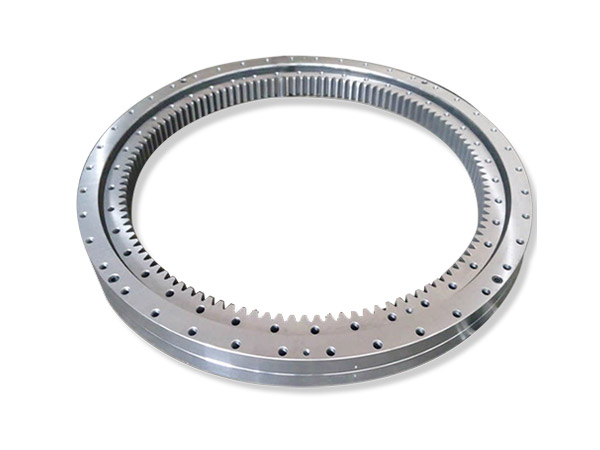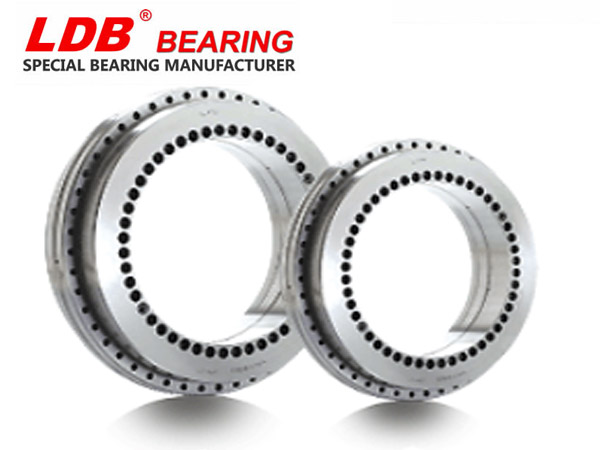Мы знаем, что качество самого поворотного подшипника является основным фактором, влияющим на срок службы подшипника, но нет, потому что помимо качества подшипника есть еще очень важный вопрос, то есть техническое обслуживание и техническое обслуживание. подшипника во время его использования, но как сохранить поворотный подшипник во время использования?
Смазка поворотного подшипника

1. Смазка
(1) Уменьшить трение и износ. Во взаимных контактных частях колец, тел качения и сепараторов, составляющих подшипник, предотвращается контакт металлов, а также уменьшается трение и износ.
(2) Продлить усталостную жизнь. Усталостная долговечность подшипника при качении увеличивается, когда поверхность контакта качения хорошо смазывается во время вращения. И наоборот, если вязкость масла низкая и толщина пленки смазочного масла недостаточна, она будет укорочена.
(3) Отвод тепла от трения и охлаждение. Метод циркуляции масла и т. Д. Может использовать масло для отвода тепла, выделяемого трением, или тепла извне, и его охлаждения. Предотвратите перегрев подшипника и предотвратите старение самого смазочного масла.
(4) Другие. Это также предотвращает попадание инородных тел внутрь подшипника или предотвращает ржавчину и коррозию.
2. Метод смазки
Методы смазки подшипников делятся на смазку консистентной смазкой и смазку маслом. Чтобы подшипник хорошо функционировал, прежде всего, необходимо выбрать метод смазки, подходящий для условий использования и цели использования. Если рассматривать только смазку, преобладает смазывающая способность масляной смазки. Однако консистентная смазка имеет то преимущество, что упрощает конструкцию вокруг подшипника. Сравните преимущества и недостатки консистентной смазки и смазки маслом.
Очистка опорно-поворотного механизма
1. Выбор чистящих средств
В качестве чистящего средства обычно используют чистящее средство и керосин. Кроме того, обратите внимание на герметизацию чистящего средства, когда оно не используется, чтобы избежать попадания внешних магазинов и загрязнения чистящего средства. В случае невнимательности очистка подшипника загрязненным чистящим средством не только не окажет очищающего действия, но загрязнит подшипник и вызовет его загрязнение. Бег приносит стресс.
2. Меры предосторожности при очистке
(1) Разобранный подшипник очищается, разделяется на грубую и тонкую очистку и помещается в контейнер соответственно, сначала на дно металлической сетки, чтобы подшипник не контактировал напрямую с грязью контейнера.
(2) Во время грубой очистки, если подшипник вращается с грязью, это повредит поверхность качения подшипника, поэтому будьте осторожны. В масле для грубой очистки используйте щетку для удаления жира и налипаний. После грубой очистки переходите к тонкой очистке.
(3) Тонкая очистка заключается в тщательной очистке подшипника при вращении в чистящем масле.

Техническое обслуживание опорно-поворотного устройства
1. Метод обслуживания
(1) Проверьте состояние поверхности дорожки качения, поверхности качения и сопрягаемой поверхности, износ сепаратора, увеличение зазора в подшипнике, а также наличие повреждений и аномалий, не связанных с уменьшением точности размеров.
(2) В случае небольших шарикоподшипников поддерживайте горизонтальное внутреннее кольцо одной рукой и вращайте наружное кольцо, чтобы проверить его гладкость. Для разъемных подшипников, таких как конические роликоподшипники, элементы качения и поверхность дорожек качения наружного кольца можно осматривать отдельно.
2. Меры предосторожности при обслуживании
(1) Чтобы решить, можно ли использовать разобранный подшипник, его следует проверить после очистки подшипника.
(2) Для разборки подшипника следует использовать специальные инструменты, а также этапы и методы разборки, чтобы избежать повреждения подшипника из-за разборки подшипника для обслуживания, которое не стоит потерь.
(3) Поскольку большие подшипники нельзя вращать вручную, обратите внимание на внешний вид тел качения, поверхностей дорожек качения, сепараторов, поверхностей ребер и т. д. Чем выше важность подшипника, тем более тщательный осмотр требуется.
Выше приведено краткое описание того, как обслуживать и обслуживать поворотный подшипник во время использования поворотного подшипника. Видно, что навыки технического обслуживания при использовании поворотного подшипника включают смазку, очистку и техническое обслуживание.
При смазке подшипников следует обратить внимание на выбор соответствующих смазочных материалов, обратить внимание на различие между грубой и тонкой промывкой при очистке, а также обратить внимание на разборку, вращение и другие вопросы при капитальном ремонте.














